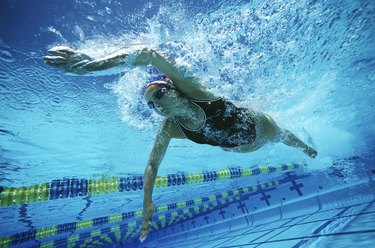
When you're trying to lose weight, you might consider jogging or even walking as your exercise plan. But there are plenty of different types of aerobic workouts that have similar health benefits without the potentially harmful impact on your joints, like swimming a mile a day.
Tip
One mile in a 25-meter pool is 64 laps, and one mile in a 50-meter pool would be 32 laps. If you’re swimming at least a mile a day for several weeks, you’ll start seeing the benefits of the whole body workout, including losing weight and building muscle.
Video of the Day
Swimming a Mile a Day
To lose weight swimming a mile a day, first estimate how many laps you'd need to swim a mile in your pool. Most outdoor and indoor pools, whether built for recreation or lap swimming, are either 25 or 50 meters long. To swim a mile in a 25-meter pool, you'd need to swim the length of the pool 64 times, according to FINA, or Federation Internationale de Natation. And to do that in a 50-meter pool, you'd need to complete 32 laps.
Video of the Day
Read more: Why Breathe Out of the Nose When Swimming?
Build Your Sets and Strokes
When swimming, you don't have to lap back and forth in the same way each time — this could get monotonous after a while. Changing up your routine can help you increase your speed and strength.
According to FINA, breaking down your mile-a-day workout into a warm-up, main set, contrast set and warm down can help. For your main set, you can break down your mile or 60 laps into doing 10 laps six times, with a one-minute break in between each. If you want to work on your long distance endurance; however, you can swim one entire mile without stopping as well.
In addition, there are four main swim strokes: front crawl, breaststroke, backstroke and butterfly. Each has its own benefits. For example, front crawl allows you to go the fastest, while butterfly requires more strength and endurance. Switching up your stroke will help you work different muscle groups and build strength and aerobic endurance.
Work Up to Speed
Depending on your skill level, it may take you up to 40 minutes to swim a mile if you're going slowly and stopping for quick breaks between laps. For more experienced and competitive swimmers, that time could be halved when swimming a mile.
The faster you swim or the more often you do sprints, the more calories you'll burn, and the more you'll get that full-body workout. Swimming raises your heart rate, building endurance and cardiovascular health. It also improves lung function, according to the State Government of Victoria, Australia Department of Health & Human Services.
Read more: Swimming After a C-Section
Do It Daily
Because swimming is an all-body workout, using nearly all of your muscles including your abs, you will typically burn more calories than you would running for the same amount of time. A 125-pound person will burn around 300-330 calories every 30 minutes swimming, compared to burning around 240 calories while running the same amount of time at 5 miles per hour, according to Harvard Health Publishing.
The hunger pains post-swimming are real, and often more intense than the energy demand your body would need after other aerobic exercises. That being said, if you're swimming a mile a day, you'll need to adjust your daily meal intake appropriately.
High-carbohydrate foods are actually good for swimming, but choose healthy ones, such as whole-grain breads or cereals. Complex carbohydrates, like whole-grain bread and legumes, actually fuel you for longer than simple carbohydrates like candy or soda, according to the American Heart Association. It's also important to choose a good amount of protein to add to your diet, as well as fruits and vegetables, to give you the energy you'll need to swim a mile every day.